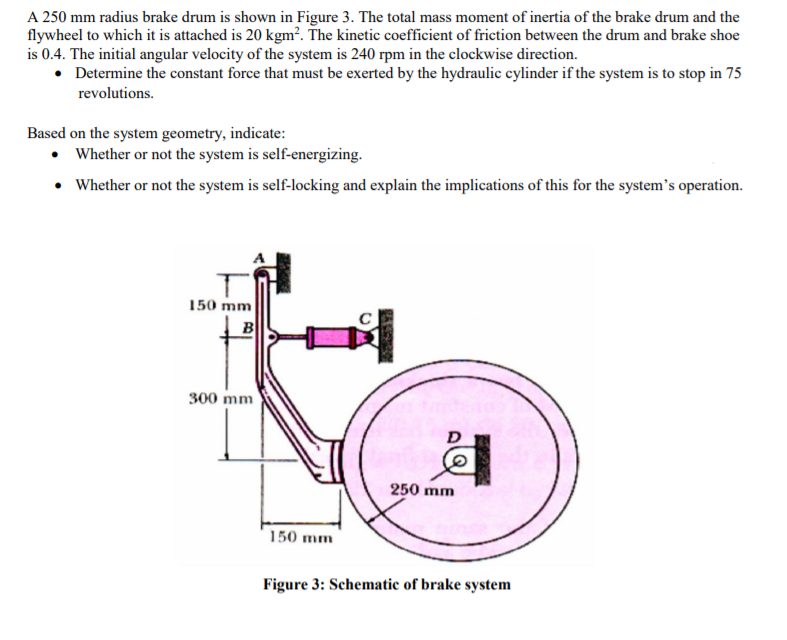A 250 mm radius brake drum is shown in Figure 3. The total mass moment of inertia of the brake drum and the flywheel to which it is attached is 20 kgm². The kinetic coefficient of friction between the drum and brake shoe is 0.4. The initial angular velocity of the system is 240 rpm in the clockwise direction. • Determine the constant force that must be exerted by the hydraulic cylinder if the system is to stop in 75 revolutions.
A 250 mm radius brake drum is shown in Figure 3. The total mass moment of inertia of the brake drum and the flywheel to which it is attached is 20 kgm². The kinetic coefficient of friction between the drum and brake shoe is 0.4. The initial angular velocity of the system is 240 rpm in the clockwise direction. • Determine the constant force that must be exerted by the hydraulic cylinder if the system is to stop in 75 revolutions.
Elements Of Electromagnetics
7th Edition
ISBN:9780190698614
Author:Sadiku, Matthew N. O.
Publisher:Sadiku, Matthew N. O.
ChapterMA: Math Assessment
Section: Chapter Questions
Problem 1.1MA
Related questions
Question
What is the constant force?

Transcribed Image Text:A 250 mm radius brake drum is shown in Figure 3. The total mass moment of inertia of the brake drum and the
flywheel to which it is attached is 20 kgm². The kinetic coefficient of friction between the drum and brake shoe
is 0.4. The initial angular velocity of the system is 240 rpm in the clockwise direction.
• Determine the constant force that must be exerted by the hydraulic cylinder if the system is to stop in 75
revolutions.
Based on the system geometry, indicate:
• Whether or not the system is self-energizing.
• Whether or not the system is self-locking and explain the implications of this for the system's operation.
150 mm
B
300 mm
250 mm
150 mm
Figure 3: Schematic of brake system
Expert Solution
This question has been solved!
Explore an expertly crafted, step-by-step solution for a thorough understanding of key concepts.
This is a popular solution!
Trending now
This is a popular solution!
Step by step
Solved in 2 steps with 1 images

Knowledge Booster
Learn more about
Need a deep-dive on the concept behind this application? Look no further. Learn more about this topic, mechanical-engineering and related others by exploring similar questions and additional content below.Recommended textbooks for you

Elements Of Electromagnetics
Mechanical Engineering
ISBN:
9780190698614
Author:
Sadiku, Matthew N. O.
Publisher:
Oxford University Press

Mechanics of Materials (10th Edition)
Mechanical Engineering
ISBN:
9780134319650
Author:
Russell C. Hibbeler
Publisher:
PEARSON

Thermodynamics: An Engineering Approach
Mechanical Engineering
ISBN:
9781259822674
Author:
Yunus A. Cengel Dr., Michael A. Boles
Publisher:
McGraw-Hill Education

Elements Of Electromagnetics
Mechanical Engineering
ISBN:
9780190698614
Author:
Sadiku, Matthew N. O.
Publisher:
Oxford University Press

Mechanics of Materials (10th Edition)
Mechanical Engineering
ISBN:
9780134319650
Author:
Russell C. Hibbeler
Publisher:
PEARSON

Thermodynamics: An Engineering Approach
Mechanical Engineering
ISBN:
9781259822674
Author:
Yunus A. Cengel Dr., Michael A. Boles
Publisher:
McGraw-Hill Education

Control Systems Engineering
Mechanical Engineering
ISBN:
9781118170519
Author:
Norman S. Nise
Publisher:
WILEY

Mechanics of Materials (MindTap Course List)
Mechanical Engineering
ISBN:
9781337093347
Author:
Barry J. Goodno, James M. Gere
Publisher:
Cengage Learning

Engineering Mechanics: Statics
Mechanical Engineering
ISBN:
9781118807330
Author:
James L. Meriam, L. G. Kraige, J. N. Bolton
Publisher:
WILEY